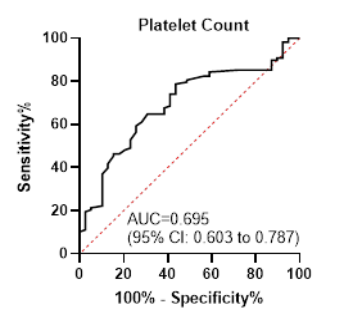Platelet count/spleen diameter ratio for the non-invasive diagnosis of esophageal varices in Iranian patients with cirrhosis
Platelet count/spleen diameter ratio and esophageal varices
Keywords:
Platelet count, Spleen diameter, Platelet count/spleen diameter ratio, Hepatic cirrhosis, Esophageal varicesAbstract
Introduction: Esophageal varices (EVs) carry a significant risk of rupture and subsequent life-threatening bleeding. While previous research has investigated the effectiveness of the platelet count to spleen diameter ratio (PC/SD) as a non-invasive predictor of EVs in various populations, this study specifically focuses on the Iranian population to assess the applicability and effectiveness of this parameter in this region.
Materials and Methods: Upper gastrointestinal endoscopy was performed on 147 cirrhotic patients to screen for EVs. Biochemical tests and ultrasonography were done to measure spleen diameter (SD) and calculate the PC/SD ratio. ROC analysis was done to determine the predictive performance of the parameters.
Results: Among the patients, 73% had EVs. The analysis showed the following: platelet count (PC) had an AUC of 0.695 with 78.7% sensitivity and 56.4% specificity; SD had an AUC of 0.750 with 49.1% sensitivity and 89.7% specificity; and the PC/SD ratio had an AUC of 0.734 with 60.2% sensitivity and 79.5% specificity. The PC/SD ratio exhibited a high positive predictive value of 93% but a low negative predictive value of 41.9%. Optimal cutoff values were determined as follows: PC≤ 100,000, SD< 163, and PC/SD ratio≤ 523.
Conclusion: By identifying high-risk patients who may benefit from targeted endoscopic screening, this non-invasive method could contribute to improving overall patient care and reducing the need for invasive procedures. However, due to suboptimal performance results, it is crucial to use this approach with caution, as endoscopic screening remains the standard practice for the diagnosis and management of esophageal varices.

Additional Files
Published
How to Cite
License
Copyright (c) 2024 Seyed-Kazem Hosseini-Ghaziani, Afshin Shafaghi, Farahnaz Joukar, Negin Letafatkar, Arman Habibi, Saman Maroufizadeh, Saba Fakhrieh Asl

This work is licensed under a Creative Commons Attribution-NonCommercial 4.0 International License.
